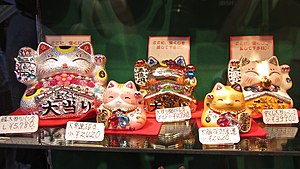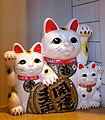Maneki-neko

The maneki-neko (招き猫, lit. 'beckoning cat') is a common Japanese figurine which is often believed to bring good luck to the owner. In modern times, they are usually made of ceramic or plastic. The figurine depicts a cat, traditionally a calico Japanese Bobtail, with a paw raised in a beckoning gesture. The figurines are often displayed in shops, restaurants, pachinko parlors, dry cleaners, laundromats, bars, casinos, hotels, nightclubs, and other businesses, generally near the entrance,[1] as well as households.[2] Some maneki-neko are equipped with a mechanical paw which slowly moves back and forth.
Maneki-neko come in different colors and styles and vary in degrees of detail. Common colors are white, black, red, and gold. In addition to statues, maneki-neko can be found in the form of keychains, piggy banks, air fresheners, pots, and numerous other media. Maneki-neko are sometimes referred to simply as "lucky cats" or "calling cats".[2]
Common features
[edit]
Maneki-neko are traditionally depicted seated, holding a koban coin, with one paw raised in a beckoning gesture. To some Westerners (Italians, Spaniards and Greeks are notable exceptions) it may seem as if the maneki-neko is waving rather than beckoning.[3][4] This is due to the difference in gestures and body language recognized by some Westerners and the Japanese. The Japanese beckoning gesture is made by holding up the hand, palm down, and repeatedly folding the fingers down and back, thus the cat's appearance. Some maneki-neko made specifically for some Western markets will have the cat's paw facing upwards, in a beckoning gesture that is more familiar to most Westerners.[5]
Maneki-neko can be found with either the right or left paw raised (and sometimes both). The significance of the right and left raised paw differs with time and place.[6] A statue with the left paw raised is to get more customers, while the right paw raised is to get more money. Hence it is also said that the one with left paw is for business and the right is for home.[7]
Battery- and solar-powered maneki-neko are a modern iteration. Those sources power a simple circuit that regulates a current going through a coil, whose electromagnetic field subsequently "pushes" a magnet mounted to the end of the waving arm.[8]
Composition
[edit]
Antique examples of maneki-neko may be made of carved wood, stone and metal, handmade porcelain or cast iron.[6]
Colors
[edit]Originally, maneki-neko were white, but over the years with the combination of Feng Shui, different color variations were born. The original white color is to get good luck and overall good fortune, while black is to ward off evil, red is for good health, yellow or gold is for wealth, and pink is for romance.[7]
History
[edit]

It is commonly believed that maneki-neko originated in Tokyo (then named Edo) or, sometimes, Kyoto.[6] It is a common theory that maneki-neko as figurines originated from Imado ware sold in Asakusa during the Edo period (1603–1868). During the Tenshō era (1573–1592) of the Azuchi-Momoyama period (1573–1592), clay suitable for pottery was discovered in Imado in Asakusa, and local people began to make Imado ware. In the Edo period, potters from the Mikawa Province moved to Imado in Asakusa and further developed Imado ware, and in the Genroku era (1688–1704), Imado dolls were made, which is thought to have given rise to maneki-neko.[9] The earliest known record of maneki-neko as figurines is the marushime-neko, a variation of maneki-neko made of Imado ware in the late Edo period.[10]
One of the earliest records of maneki-neko appear in the Bukō nenpyō's (a chronology of Edo) entry dated 1852. Utagawa Hiroshige's ukiyo-e "Joruri-machi Hanka no zu," painted also in 1852, depicts the marushime-neko, a variation of maneki-neko, being sold at Sensō-ji Temple, Tokyo. In 1876, during the Meiji era, it was mentioned in a newspaper article, and there is evidence that kimono-clad maneki-neko were distributed at a shrine in Osaka during this time. A 1902 advertisement for maneki-neko indicates that by the turn of the century they were popular.[10]
There are various folklore in Japan about the origin of maneki-neko. Several Buddhist temples and Shinto shrines that appear in folklore, such as Gōtoku-ji, Jishōin Shrine and Imado Shrine, are known as the birthplaces of the maneki-neko.[11][12]

The most famous folklore concerns Ii Naotaka during the Kan'ei era (1622–1624) of the Edo period. On their way back from the falconry, Naotaka's party stopped at Gōtoku-ji Temple to rest after being beckoned by a cat at the temple gate. A violent thunderstorm soon followed, and they marvelled at the cat's good fortune and thanked the temple priest for his hospitality. As a result, Gōtoku-ji became the family temple of the Ii clan, and the temple prospered under their patronage. In honour of the cat that brought prosperity to the temple, maneki-neko was created in later generations.[13][14][9][10][11][12]
The second folklore concerns Ōta Dōkan, a warlord of the Muromachi period (1336–1573) who later became the first to build Edo Castle. During the Battles of Ekodahara and Numabukuro against the Toshima clan, Dōkan was outnumbered and lost his way. It was then that a cat appeared and beckoned him to enter the Jishōin Temple, where he was later able to turn the tide and win the war. Dōkan was so grateful to the cat that he donated a sculpture of the cat to the temple, and the maneki-neko was created in later generations.[11]
The third folklore concerns an old woman who lived near the Imado Shrine. She had abandoned her cat out of poverty. One day, the cat came to her in a dream and told her that if she made an ornament of the cat, she would be blessed with good luck. The old woman made an ornament of the cat out of Imado ware, a local speciality, and sold it at the Asakusa Shrine, where it became very popular and made her rich, and the maneki-neko was created.[11][12]
The fourth folklore concerns an oiran (courtesan) named Usugumo in Yoshiwara during the Genroku era of the Edo period. Usugumo was an oiran who worked in Miuraya and always carried a cat with her. People rumoured that Usugumo was a woman bewitched by a demonic cat, and the owner of Miuraya, believing the rumour, cut off the cat's head and killed it. The cat's severed head bit a giant snake lurking in the toilet, saving Usugumo's life. A regular customer gave Usugumo, who was grieving over the cat's death, a wooden carving in the shape of a cat, which was imitated and sold in Asakusa, giving rise to maneki-neko.[14][9]
According to a folktale, the operator of an impoverished shop (or inn, tavern, temple, etc.) took in a starving stray cat despite barely having enough to feed himself. In gratitude, the cat sat in the front of the store beckoning customers, thus bringing prosperity as a reward to the charitable proprietor. Ever after, the "beckoning cat" has been a symbol of good luck for small business owners.[6]
Beliefs
[edit]Superstitions about the maneki-neko include it being able to "beckon...customers into shops" and "bring good fortune and prosperity into households", and it being an embodiment of "fertile, life-enhancing feline energies."[2]
In popular culture
[edit]Because of its popularity in Chinese communities (including Chinatowns in the United States),[6] the maneki-neko is frequently mistaken for being Chinese in origin rather than Japanese,[13] and is therefore sometimes referred to as a "Chinese lucky cat"[6] or jīnmāo ("golden cat"). This cat is also prevalent in China domestically, and is usually referred to as simplified Chinese: 招财猫; traditional Chinese: 招財貓; pinyin: zhāocáimāo; Jyutping: ziu1 coi4 maau1.
Hikone City's mascot, Hikonyan, a famous mascot in Japan, was created based on the folklore of Ii Naotaka and the maneki-neko of Gōtoku-ji Temple. Hikone City is home to Hikone Castle, a National Treasure that was the base of the Ii clan for generations.[13][11][12]
For the 2015 Trinidad and Tobago general election, won by the then opposition People's National Movement (PNM), a maneki-neko was utilized by the PNM in its campaign advertising days before election day, featuring a maneki-neko waving goodbye to then Prime Minister Kamla Persad-Bissessar alongside headlines of scandals linked to her People's Partnership administration taken from the front page of local newspapers.[15][16]
Gallery
[edit]See also
[edit]References
[edit]- ^ Taggart, Emma (July 26, 2021). "What Is Maneki-Neko? Discover the Fascinating History of the Japanese Lucky Cat". My Modern Met.
- ^ a b c Carlson, Kathie; Flanagin, Michael N.; Martin, Kathleen; Martin, Mary E.; Mendelsohn, John; Rodgers, Priscilla Young; Ronnberg, Ami; Salman, Sherry; Wesley, Deborah A. (2010). Arm, Karen; Ueda, Kako; Thulin, Anne; Langerak, Allison; Kiley, Timothy Gus; Wolff, Mary (eds.). The Book of Symbols: Reflections on Archetypal Images. Köln: Taschen. p. 300. ISBN 978-3-8365-1448-4.
- ^ Calero, Henry H. (2005). The Power of Nonverbal Communication: How You Act is More Important Than what You Say. Aberdeen, Washington: Silver Lake Publishing. p. 116. ISBN 978-1-56343-788-5.
- ^ Wibbeke, E. S. "Gestures around the World". Globalbusinessleadership.com. Archived from the original on 11 March 2017. Retrieved 4 December 2012.
- ^ Mishima, Shizuko. "Manekineko: Japanese Lucky Cats". Japan Travel. About.com. Archived from the original on 28 April 2012. Retrieved 3 August 2009.
- ^ a b c d e f Pate, Alan (2008). "Maneki Neko: Feline Fact & Fiction". Daruma Magazine. Amagasaki, Japan: Takeguchi Momoko. Archived from the original on 14 March 2013. Retrieved 30 December 2012.
- ^ a b "招き猫の色やあげている手の違いなど知られざる意味を一挙解説!" [Commentary on unknown meanings such as the color of the beckoning cat and the difference of raising hands]. nekochan.jp (in Japanese). 27 March 2019. Retrieved 18 April 2019.
- ^ Scharfglass, Kerry (2018-06-01). "An Electromagnet Brings Harmony To This Waving Cat". Hackaday. Retrieved 2024-02-15.
- ^ a b c 招き猫ってそもそも何?発祥は豪徳寺?今戸神社?秘密を徹底検証! (in Japanese). Shogakukan. 26 December 2017. Archived from the original on 2 July 2023. Retrieved 2 July 2023.
- ^ a b c 招き猫のルーツを探る ささやかな庶民の願いこめ、化け続ける (in Japanese). The Asahi Shimbun. 7 January 2017. Archived from the original on 1 June 2023. Retrieved 2 July 2023.
- ^ a b c d e 東京都の"招き猫発祥の地"である豪徳寺・自性院・今戸神社、猫はどう違う? (in Japanese). Mynavi News. 22 July 2014. Archived from the original on 7 December 2022. Retrieved 2 July 2022.
- ^ a b c d 招き猫発祥地争い 浅草・今戸神社と世田谷・豪徳寺が主張中 (in Japanese). Shogakukan. 6 March 2016. Archived from the original on 15 October 2021. Retrieved 2 July 2023.
- ^ a b c "Fortune Beckons: Japan's Lucky Cat Figurines". nippon.com. 1 August 2014. Archived from the original on 9 November 2018. Retrieved 2 July 2023.
- ^ a b ""Waneko" Studies: A Journey into Japan's Cat Lore". nippon.com. 23 April 2021. Archived from the original on 31 January 2023. Retrieved 2 July 2023.
- ^ Bye Bye Kamla, Bye Bye!, 2 September 2015, retrieved 2024-03-27
- ^ Bye Bye Kamla, Bye Bye! | Bye Bye Kamla, Bye Bye! #VotePNM2015 #RedandReady | By PNM - The People's National MovementFacebook, retrieved 2024-03-27
Bibliography
[edit]- Dale-Green, Patricia (1963). The Cult of the Cat. Boston: Houghton Mifflin. ISBN 978-0-517-17500-2.
- Daniels, Inge Maria (2003). "Scooping, raking, beckoning luck: luck, agency and the interdependence of people and things in Japan". Royal Anthropological Institute. 9 (4): 619–638. doi:10.1111/j.1467-9655.2003.00166.x.
- Masuda, Koh, ed. (1991). Kenkyusha's New Japanese-English Dictionary (4 ed.). Tokyo: Kenkyusha Limited. ISBN 4-7674-2025-3.
- Pate, Alan Scott (2011). Maneki Neko. San Diego: Mingei International Museum. ISBN 978-0-914155-25-6.
- Wellman, Laurel (2004). Lucky Cat: He Brings You Good Luck. San Francisco: Chronicle Books. ISBN 0-8118-4121-9.
External links
[edit] Media related to Maneki neko at Wikimedia Commons
Media related to Maneki neko at Wikimedia Commons












